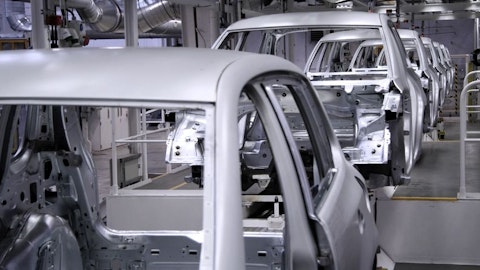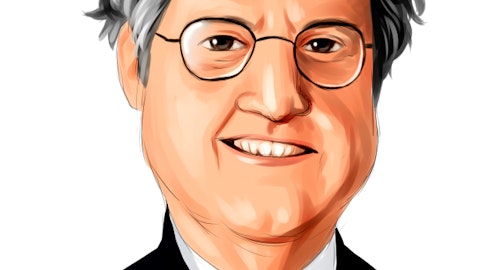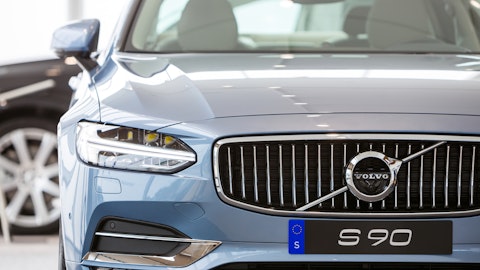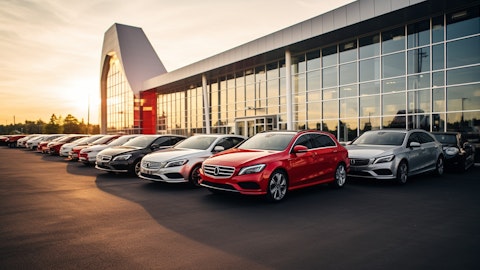Stellantis N.V. (NYSE:STLA) Q3 2023 Earnings Call Transcript November 5, 2023
Operator: Ladies and gentlemen, welcome to the Stellantis Q3 2023 Shipments and Revenues Call. I will now hand over to our host, Mr. Ed Ditmire, Head of Investor Relations at Stellantis. Mr. Ditmire, please go ahead.
Ed Ditmire: Hello, everyone and thank you for joining us today as we review Stellantis’ Q3 2023 shipments and revenues. Earlier today, the presentation material for this call, along with the related press release were posted on the Investors section of the Stellantis Group website. Today, our call is hosted by Natalie Knight, the company’s Chief Financial Officer. After her presentation, Ms. Knight will be available to answer questions from the analysts. Before we begin, I want to point out that any forward-looking statements we might make today during the call are subject to the risks and uncertainties mentioned in the Safe Harbor statement included on Page 2 of today’s presentation. And as customary, the call will be governed by that language. Now, I would like to hand over the call to Natalie Knight, CFO of Stellantis.
Natalie Knight: Thanks, Ed. I’m excited to be here with everybody today and talk about our strong Q3 performance. This was a period where net revenue growth and continued shipment momentum really shone through. We took on critical short-term industry challenges like the union negotiations in North America head-on and made strategic moves that demonstrate we are clearly on track to achieve our Dare Forward 2030 ambitions. Let’s now turn to our first chart. At 1.4 million units, Q3 shipments grew 11% year-over-year, and our net revenues increased 7% to EUR 45 billion. This development was supported by our unique, high-performing Third Engine markets, where revenues were up 25% year-over-year due to the share gains in both South America as well as the Middle East and Africa.
Our efforts on electric vehicles also continue to accelerate. LEV sales grew 50% in the quarter, and we moved back into the number 2 position in BEV sales in the Europe 30 markets. Regaining that spot that we had lost to Tesla in Q2 and setting ourselves up to finish the year and enter 2024 with strong momentum. This is especially exciting because of the significant expansion of our electrified offering next year, including, for example, the all-new Citroen E-C3, which we unveiled two weeks ago. Arriving in Q2 2024, this car, which is pictured here on the chart, it looks great. It meets industry expectations and all EV performance metrics, and it’s a leader when it comes to the all-important affordability criteria. At EUR 23,300 we are the first major carmaker to offer a BEV in Europe, which is manufactured in Europe at a price below EUR 25,000.
And towards 2025, we’ll break the next price threshold with our urban variant, calibrated for lower range needs at just under EUR 20,000. The launch reception has convinced us that there will be strong demand for this product and let me add that I think these vehicles – in fact, I know, these vehicles are going to be profitable from day one at Stellantis. Earlier this month, we also presented two major building blocks to our Dare Forward 2030 plan with the announcement of our new strategic partnership with Leapmotor and the launch of our Pro One commercial vehicle strategy, each of which I’ll discuss briefly today. Another very important topic to address is the labor negotiations with our North American workers represented by the UAW in the US and by Unifor in Canada.
The combined negative impacts of our shipments from both of these strikes was around 50,000 units in September and October, with an associated net revenue impact close to EUR 3 billion. We’re very pleased to have reached a tentative agreement with both UAW and Unifor in the last several days, but that also means we’re limited in our ability to provide additional details at this time out of respect for the remaining steps as the union leadership teams are now in the process of communicating details and putting ratification decisions to their members. Let me now turn to market share, where overall performance was lower in both of our largest markets versus the year ago period. It’s important to note, however, that in Europe, our market share grew in the month of September, and that’s momentum we expect to build further in Q4.
While in North America, we continue to focus on improving our sales and marketing effectiveness and optimizing the mix. The next chart is about our Commercial Vehicles business, where we recently launched our new Pro One multi-brand plan of attack to obtain market leadership. CVs represent one-third of Stellantis revenues and we have regional leadership in Europe and South America with strong positions in the Middle East and Africa as well as in North America. We have been producing commercial vehicles for 120 years, the loyalty rates are sky-high and the profitability exceeds our already high group standard. To keep pushing forward, we presented a full renewed lineup of not just one, but 12 vans each offering BEV variants. Adding to that, we will be launching four Ram electrified vehicles in the next 24 months, starting with Ram ProMaster later this year.
Our entire CV offering will also be fully connected in terms of software by the end of this year, and we intend to double our CV net revenues by 2030 versus 2021 and generate EUR 5 billion in CV software and services. As a result, we’re now targeting the number 1 position in commercial vehicles by 2027 and that’s three years ahead of our original Dare Forward 2030 ambition. I’d now like to turn to our announcement from last Thursday about our exciting new partnership with the Chinese EV pure-player, Leapmotor. We will invest EUR 1.5 billion to acquire a 20% equity stake in Leapmotor and are setting up a Stellantis-led joint venture, which will hold the exclusive rights to export and manufacture Leapmotor products outside of China. This will help us move into an offensive position where when it comes to the strong secular trend of rising BEV exports, which are projected to more than double in terms of sales outside China by 2030.

At the same time, we’ll be participating in Leapmotor’s impressive growth story within China with being part of that elite group of tech-led local NEV pure-players that we believe will belong to the long-term winners in the world’s largest car market. Lastly, we believe this partnership will provide outstanding real-time insights for our core business based on the dynamic, highly verticalized Chinese EV ecosystem that we can use to benchmark and challenge our core Stellantis business to innovate and win in new ways. We expect to be in position pending regulatory approvals to start shipping from our new export JV, Leapmotor International in late 2024. And in 2030, we’re targeting more than 500,000 units of annual export volume on top of Leapmotor’s own goal to have at least 1 million units annually in their domestic Chinese market.
This partnership will play a key role in the Stellantis growth story, but play at no expense to profitability, where this deal will be accretive to our AOI in 2025 and enhance our margins in the longer-term. Turning now to our key financial figures for the period. Shipments increased 11% in Q3 and revenues grew 7% to EUR 45 billion, as I mentioned earlier. This continues our strong year-to-date trend. As you can see here, negative currency translation effect dampened this performance, but the underlying trends are strong. In the third quarter, we added over EUR 3 billion to the Stellantis’ top line, thanks to strong shipment growth and carefully calibrated pricing, which helped us to offset nearly EUR 3 billion of negative FX impacts. The very strong performance of our Third Engine contributed more than 50% of our revenue increase.
So now let’s briefly discuss the shipments and revenue performance by segment on our next chart. In both North America and, in large, Europe, higher shipments plus modest pricing gains drove solid net revenue growth. The Middle East and Africa was again our strongest growing segment with shipments passing the 100,000 unit mark to more than double last year’s volume as we continue to benefit from our unique leading positions in Algeria with the successful introduction of the Fiat brand and in Turkey with our powerful Peugeot, Opel and Fiat brands. Net revenues in the region grew even more with a 128% increase to reach EUR 3 billion helped by positive net pricing and also benefiting from hyperinflation in Turkey. Looking at our next chart, where in South America, shipments and revenues grew 7% and 8%, respectively, in Q3, the positive net pricing more than offset negative FX impacts, particularly from the devaluation of the Argentinian peso.
Lower shipments in China, India, Asia Pacific led to a decrease in net revenues and in line with the trends of other Western car and luxury brands in China, Maserati also experienced lower shipments against the prior period. Turning to the next chart. I’d like to comment on our new vehicle inventories, which were virtually unchanged versus Q2 levels when we last published these results. Global inventories have remained stable at around 1.4 million units. However, this hype in improvement in Europe, where our outbound logistics are continuing to improve, allowing us to reduce inventories. This improvement was offset by slightly higher inventories in North America, given that we have prepared our inventory levels for potential strike scenarios, which would have impacted production even more than what we ultimately experienced.
In terms of global inventory mix, we were able to reduce levels held by independent retailers to around 1 million units, while company-owned inventory increased 68,000 units in line with seasonal trends. Looking longer-term across 12-month intervals, you can see that we are now at a more normalized level compared to the highly supply-constrained 2020 to 2022 period and have significantly tightened our inventory levels versus our pre-merger predecessors as the decline versus 2019 shows. And finally, in this section, let me touch on our order book which has moved from four months at the end of the second quarter to around three months at the end of this period. This is right where we always want to be, because it allows us to have solid revenue visibility but we’re also improving our ability to serve customers in a reasonable timeframe.
Moving on to our outlook and guidance. The industry continued to show strong overall demand in the third quarter, leading us to raise our full year 2023 industry outlook in three of the six regions. And we exited Q3 with confidence in our continued strong revenue performance, progress on strategic objectives and short-term industry challenges. As a result, we’re confirming our financial guidance where we intend to deliver double-digit adjusted operating income margin both in Q4 and for the full year and the positive industrial free cash flows, which given the strong starting place in terms of H1’s EUR 8.7 billion, easily puts us within reach of 2022’s EUR 10.8 billion mark. Our focus between now and the end of the year will be on finalizing North American labor contracts so we can restore full production capacity.
Also, it will be about building momentum in BEVs, particularly in Europe, where we intend to maintain our top two standing. And finally, when looking at sales performance more broadly, we intend to drive further efforts in each of our key regions to improve share and do so while maintaining strong profitability. Let me close by looking forward, in addition to our full year 2023 results on February 25th, we’re excited to announce that we’ll be hosting a 2024 Investor Day on June 13th in Auburn Hills, Michigan. We will be sharing more information on the event in early 2024, but we’re looking forward to covering a wide range of important topics. So, please save the date. Now I’ll say thanks for listening and hand back over the operator so I can take your questions.
Operator: Thank you. [Operator Instructions] Thank you. And we’ll now take our first question from George Galliers of Goldman Sachs. Your line is open. Please go ahead.
See also 20 Best Chocolate Brands in the World and 10 High Risk High Reward Businesses in the US.
Q&A Session
Follow Stellantis N.v. (NYSE:STLA)
Follow Stellantis N.v. (NYSE:STLA)
George Galliers: Hi, Natalie and thanks for taking my questions. Just being respectful of what you said around not being able to disclose too much detail on the UAW negotiations. I wanted to just start by asking where the high level you could give any indication of what the anticipated headwinds will be for you from the higher labor contracts as we think about 2024? And also whether you could give any insight into the cost of the signing bonus and whether that would be accrued over the life of the contract or booked to the second half of this year? The second question I had was just with regards to the development of the revenue per unit in the Middle East and Africa. If we look at this, there seems to be a lot of volatility from Q1 with a big drop at Q2 and then another large step-up now at Q3.
Can you give us some insight into what’s driving that? Is it product mix or regional mix? And how we should think about that going forward given this is an increasingly large part of your business? Thank you.
Natalie Knight: Sure. Thanks for the questions. We start with UAW. I mean, maybe getting some things out that I also said in the press call earlier today, which is, we go into that position, I think, in a very healthy space versus the competition. On the one hand, the US market, it’s very important to us, but it’s a smaller piece of our overall business than what you see from our US competitors, and it’s a place where we start with a very high and healthy profitability level. When we look at kind of where we’ve ended the negotiations, I talked about the number of shipments and about the EUR 3 billion in terms of revenue hit that we’ve had this year. What I did say this morning on the press call was that, when we look at that from an AOI perspective or in terms of margin, that number is less than EUR 750 million.
And we also believe it’s the lowest of the big three in the market. So that’s just kind of getting to where we are today in terms of impact. When we look at what does that mean in terms of 2024 and beyond and your question about the ratification bonus. I’m not going to make any specific comments on those numbers, because I do want to respect the process, and I think our peers have also let UAW go through the process of talking with their members and our employees first. But what I will say is, you can expect those numbers to look very much in the same order of magnitude as what you’ve heard Ford comment on in terms of their numbers. In terms of the signing bonus and how it would be booked. That’s definitely something that you would see us look at this year in terms of going through our AOI.
So that’s a very standard piece in terms of the accounting treatment. When it comes to your comment about the revenue units on Middle East and Africa, this is one of those things where we have a very different mix impact depending on the different countries. We’re not selling our products at the same price in all those countries. So it really depends on the macroeconomic situation in each country. So, in our country mix as we see that change, then we also see the changes directly in the revenue. So it’s important at the end of the day, is, we’re really looking at the margins and how the margins develop you know this year that we had big changes in terms of our growth in the Turkish market, and we’ve now had strong growth in the Algerian market as we’ve come online there.
So it’s really about the mix between how those countries are playing into the overall.
George Galliers: Thank you.
Operator: Thank you. And we’ll now take our next question from Michael Jacks at Bank of America. Your line is open. Please go ahead.
Michael Jacks: Hi, good afternoon. Thanks for taking my questions. The first one, Natalie, is on industrial performance. So costs for the second half of this year and into next year, I think the initial guide for 2023 was for industrial cost to half versus the EUR 9 billion headwind from last year. But given that H1 was run rating well below that, that would imply an increase for the second half of this year. I would also expect that raw materials are becoming a tailwind and synergies are a tailwind as well. So, would it be reasonable to expect a more neutral cost impact in the second half of this year? And how should we think about the setup for industrial costs going into next year? And then just an additional question on Middle East and Africa, I mean it’s been quite an exceptional period for you on volumes. Would it be fair to assume some degree of normalization here going into next year? Thank you.
Natalie Knight: Okay. Quite a few things in there. I think the first one was just looking at how costs are moving for us as a business. And this is one where I think you’re right that there have been a lot of different moving parts in there this year. What we saw is that, we have had some tailwinds on raw materials, and that’s, I would say, accelerated a bit as we’ve moved throughout the year. On what we’ve been able to do ourselves as a business in terms of the transformation, that piece has also, I think we’ve been able to deliver some very positive benefits there. We do continue to see challenges on the cost side with our suppliers. But that is something that I think is actually moderating versus what you’ve seen over the last two years where they’ve been a real big run up in that area.





